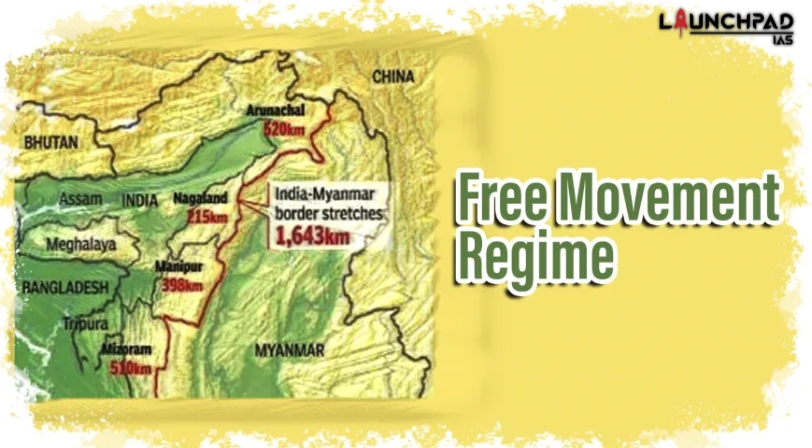Historical Context
- Much of India’s northeast region was under Burmese occupation until the Treaty of Yandaboo in 1826 established the current India-Myanmar boundary.
- The Treaty of Yandabo was signed by General Sir Archibald Campbell on behalf of the British and Governor of Legaing Maha Min Hla Kyaw Htin on behalf of the Burmese.
- It ended the First Anglo-Burmese War (1824-1826).
- However, the border separated communities with shared ethnicity and culture, including the Nagas in Nagaland and Manipur, as well as the Kuki-Chin-Mizo communities in Manipur and Mizoram, without their agreement.
- Currently, India and Myanmar share a 1,643 km border across Manipur, Mizoram, Nagaland, and Arunachal Pradesh, of which only 10 km is fenced, in Manipur.
Free Movement Regime
- The FMR was established in 2018 as part of India’s Act East policy, promoting cross-border movement up to 16 km without a visa.
- Individuals residing at the border need a one-year border pass for stays lasting up to two weeks in the neighboring country.
- It aimed to facilitate local border trade, improve access to education and healthcare for border residents, and strengthen diplomatic ties.
Potential Reasons for Reconsidering the Free Movement Regime
Security Concerns:
- Increased Infiltration: Concerns have arisen about the influx of illegal immigrants, particularly the Chin, Naga communities and Rohingyas from Myanmar, potentially straining resources and impacting local demographics.
- Drug Trafficking and Arms Smuggling: The porous border facilitates the illegal movement of drugs and weapons, posing a threat to internal security to India and fueling crime.
- Insurgency Activities: The FMR has been misused by insurgent groups operating in northeastern India, allowing them to cross the border easily and evade capture.
- E.g. Kuki National Organisation (KNO) and Kangleipak Communist Party-Lamphel (KCP-Lamphel) in Manipur.
Socio-economic and Regional Issues:
- Impact on cultural identity: Concerns exist about the preservation of indigenous culture and traditions in border areas, potentially threatened by increased migration.
- Environmental Degradation: Deforestation and illegal resource extraction along the border are attributed to unregulated cross-border movement.
- Regional Dynamics: China’s growing influence in Myanmar and its potential impact on border security add another layer of complexity to the situation.
Key Features of Free Movement Regimes of Other Countries
- Visa-Free Travel: Citizens of member states can travel freely within the region without the need for visas or with simplified visa procedures.
- Residence Rights: Some agreements allow citizens to live and work in any member state without additional permits.
- Removal of Border Controls: Borders within the region may be open, with the elimination of passport controls and customs checks.
- Harmonization of Policies: Member states often work towards aligning immigration, labor, and social policies to facilitate seamless movement.
- Economic Integration: Free movement regimes are often part of broader economic integration efforts, fostering cooperation in trade, investment, and other economic activities



